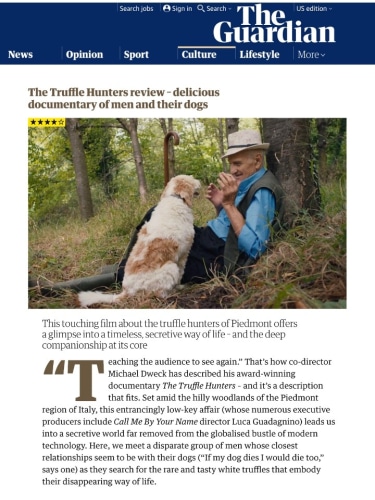The Truffle Hunters review – delicious documentary of men and their dogs
The Guardian
07/11/2021
Back
★★★★☆
By Mark Kermode
This touching film about the truffle hunters of Piedmont offers a glimpse into a timeless, secretive way of life – and the deep companionship at its core
“Teaching the audience to see again.” That’s how co-director Michael Dweck has described his award-winning documentary The Truffle Hunters – and it’s a description that fits. Set amid the hilly woodlands of the Piedmont region of Italy, this entrancingly low-key affair (whose numerous executive producers include Call Me By Your Name director Luca Guadagnino) leads us into a secretive world far removed from the globalised bustle of modern technology. Here, we meet a disparate group of men whose closest relationships seem to be with their dogs (“If my dog dies I would die too,” says one) as they search for the rare and tasty white truffles that embody their disappearing way of life.
The tone is set by a lengthy opening long-shot – a slow zoom into rich green and yellow foliage amid which the figure of a man is at first indistinguishable from the landscape. Like the face-through-the-fronds introduction of King-Lu in Kelly Reichardt’s First Cow, this lone figure seems somehow secondary to his surroundings, his canine companions making more of a visual impact than their human “master”.
It soon becomes clear that, in this world, men and dogs are very much on an even footing. Octogenarian Aurelio may appear to live alone, but the bond he shares with his beloved Birba is as deep as any family ties could ever be (“Why don’t I get married? Because I have Birba!”). This odd couple live, work and eat together, with Aurelio tenderly discussing matters of life and death with his companion, diligently making plans for his own inevitable departure. Meanwhile, Sergio bathes and blow-dries his dogs between bouts of cathartic rock drumming, while Carlo’s disapproving wife thinks he’s too old to be scouring the woods by night with his blessed companion Titina (“But I like to listen to the owl … and if I fall it’s my pain”).
While much of the fixed-camera footage has a distinctly painterly edge (Caravaggio and Raphael were apparently key influences), co-directors Gregory Kershaw and Dweck also mount tiny cameras on the heads of the dogs to capture the thrill of the hunt – a frenetic pursuit that proves unexpectedly gripping, particularly considering that the quarry is not darting nimbly between trees but simply hiding beneath the ground, impassive and invisible.
Having previously collaborated on the elegiac 2018 stock-car doc The Last Race, Dweck and Kershaw spent years earning the trust of their subjects, documenting their lives with empathy, honesty and a generous helping of melancholy humour. Through their eyes we discover an ecosystem that is ruggedly permanent yet fragile and transitory, in danger of extinction. Deteriorating soil, poisonous competition and the depletion of woodlands are all part of the problem, with one retiring hunter declaring that nowadays “people are greedy… they know nothing about the forest but they want to plunder it”.
With adroit understatement, the directors juxtapose verdant visions of nature with more sinister images of the truffle trade. From that sublime outdoor opening we cut to a starker, more sterile shot of a dealer negotiating presidential sales of prized tubers, assuring his client of the pricey value of his wares while noting ironically that “I can’t send you the aroma by phone.” No wonder Aurelio seems determined to take his own truffle-hunting secrets to his grave, sharing them only with Birba and insisting that if he had a child, he wouldn’t even tell them.
Every bit as immersive as Victor Kossakovsky’s recent documentary Gunda, about a sow and her piglets, The Truffle Hunters serves as a timely reminder that the world does not turn to the industrialised rhythms of mankind alone, and that we lose track of its natural heartbeat at our peril. Joyous on-camera song (both a cappella and with accordion) is deployed to sublime effect, with sound designer Stephen Urata weaving barks, bells, creaks and wind-whistles together in symphonic fashion.